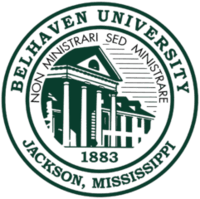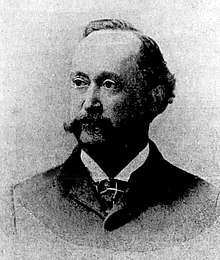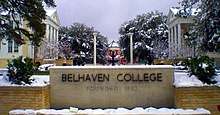Belhaven University
 | |
Former names |
Belhaven College for Young Ladies Belhaven Collegiate and Industrial Institute Belhaven College |
|---|---|
| Motto | Non Ministari Sed Ministare (Latin) |
Motto in English | Not To Be Served But To Serve |
| Type | Private |
| Established | 1883 |
| Affiliation | Presbyterian |
| President | Roger Parrott |
| Students | 4,245 |
| Location | Jackson, Mississippi, U.S. |
| Colors |
Green and Gold |
| Athletics | NCAA Division III |
| Nickname | Blazers |
| Affiliations |
CCCU NAICU[1] APCU |
| Website |
www |
 | |
Belhaven University ("Belhaven" or "BU") is a private Christian liberal arts university located in Jackson, Mississippi, founded in 1883. The university offers traditional majors, programs of general studies, and pre-professional programs in Christian Ministry, Medicine, Dentistry, Law, and Nursing.
Belhaven has extended its reach geographically and to adult and evening students at satellite campuses for graduate and undergraduate studies in Atlanta, Chattanooga, Dalton. Houston, Madison, Memphis, Orlando, and online programs.
Belhaven teaches from a Christian worldview curriculum and defines its mission as preparing "students academically and spiritually to serve Jesus Christ in their careers, in human relationships, and in the world of ideas."[2]
History


Belhaven University was founded in 1883 through the merger of the Mississippi Synodical College and The McComb Female Institute. In 1894, the college opened in its current location in Jackson, Mississippi on Peachtree Street in the historic Belhaven Neighborhood.[3]
The school opened in the residence of Colonel Jones S. Hamilton, a Confederate veteran who became a millionaire after the war through investments in railroads run by convicts he leased.[4] The school took the name Belhaven in honor of Hamilton's mansion, which was named after his ancestral home in Scotland.[5]
In 1921, the Reverend Guy T. Gillespie of Lexington, Mississippi, began a 33-year presidency during which Belhaven was first accredited, an endowment fund begun, and scholarships made available. In 1939, Belhaven was merged with the Mississippi Synodical College, a college in Holly Springs, Mississippi which had been opened in 1883.[6] This date was adopted by the Board of Trustees as the official founding date of Belhaven as it represented the oldest founding date of all of the institutions which were eventually absorbed into the college.
A major fire devastated the college on August 9, 1927 when lightning struck the school's only building. The columns that stand in the middle of campus are the approximate site of the fire. Today, Fitzhugh and Preston Halls are the remnants of the main building destroyed in the fire.
In 1954, the Board of Trustees voted to allow the enrollment of male students, making Belhaven a fully co-educational institution. The school added men's basketball and men's tennis as intercollegiate sports in 1956. Dr. McFerran Crowe succeeded Gillespie as President and over the next six years he expanded and upgraded the faculty, while also reorganizing and modernizing business operations.[3] The first singing Christmas tree in the world debuted at Belhaven in 1933.
From 1960 to 1961, Dr. Robert F. Cooper served as acting president until the board selected Dr. Howard J. Cleland, then principal of nearby Murrah High School, to replace him. Under Cleland's 17-year tenure, an ambitious expansion program resulted in six major new buildings, while enrollment and the college budget tripled. In 1965, a faculty member was fired for being gay.[7] In 1972, the Synod of Mississippi officially transferred ownership of the college to the board of trustees, making Belhaven a fully independent college. In March, 1978, Doctor Verne R. Kennedy became the first Belhaven alumnus to serve as the chief executive of Belhaven College. In his eight years as president he reaffirmed the commitment to Christian service and the covenant relationship with the Presbyterian Church, and installed a more efficient administrative structure. In June 1986, another alumnus of Belhaven, Dr. Newton Wilson, became president. His nine-year term saw the greatest growth in the history of the college, from just over 600 students to more than 1,100.[3]
Dr. Verne R. Kennedy followed as President, and was the first Belhaven alumnus to serve as the school's chief officer. Kennedy reaffirmed the college's commitment to Christian service and its relationship with various Presbyterian denominations. Under Kennedy, Belhaven joined the Council for Christian Colleges and Universities.
By 1995, over 80 percent of Belhaven's faculty held doctoral or equivalent degrees. Dr. Daniel C. Fredericks served as acting president in 1995. In January 1996, Doctor Roger Parrott became the tenth president of the college, with about 1,300 enrolled students. Under his leadership, Belhaven has added seven major buildings, a variety of new undergraduate academic majors and graduate programs, intercollegiate football, campuses in Memphis, Orlando, Houston, Chattanooga, and Atlanta, online programs, the "Christian Worldview Curriculum", and earned national accreditation in all four of the major arts (Music, Theater, Visual Arts, and Dance). The size of the student body has nearly quadrupled during his tenure.[3]
The school maintains a close church connection. Many faculty and staff members are drawn from various Presbyterian denominations, primarily the Presbyterian Church (U.S.A.), the Presbyterian Church in America, and the Evangelical Presbyterian Church. The college receives both financial support and students from these three denominations as well.
Name changes
Belhaven has gone through various name changes over the years. Four major name changes have taken place, although the name "Belhaven" has been common to them all. The school was founded as "Belhaven College for Young Ladies" in 1894. After the original location burned in a fire in 1910, Belhaven was reopened as "The Belhaven Collegiate and Industrial Institute" in 1911 at its current location on Peachtree Street in the historic Belhaven Neighborhood in Jackson. In 1915, the Board of Trustees further changed the school's name to "Belhaven College".
In December, 2009, President Roger Parrott announced that the Board of Trustees had voted unanimously to change the name from "Belhaven College" to the current name of "Belhaven University", effective on January 1, 2010. Among the reasons cited for the name change were the addition of several new graduate programs of study and a total enrollment of more than 3,000 students across four locations, including over 500 graduate students.[3]
Academics
Belhaven University offers Bachelor's Degrees in 27 different major areas of study.[8] Master's Degrees are offered in Business Administration, Leadership, Public Administration, Teaching, and Education, among others.[9]
The five most popular majors among 2009 graduates were Visual and Performing Arts (22%), Business, Management, Marketing, and related support services (17%), Health and Physical Education/Fitness (11%), Education (9%), and Psychology (8%).[10]
Fine arts
Belhaven University is nationally accredited by the National Association of Schools of Art and Design,[11] the National Association of Schools of Music,[12] the National Association of Schools of Dance[13] and the National Association of Schools of Theater,[14] making Belhaven one of only 36 colleges and universities accredited in the all four of the major arts (Visual Arts, Music, Dance and Theater).
Accreditation
Belhaven is accredited by the Southern Association of Colleges and Schools to award Associate, Baccalaureate, and master's degrees. Twenty-seven Bachelor's Degrees and eight Master's Degrees are offered. Departments offering specific majors are further accredited as follows: The Department of Music is an accredited institutional member of the National Association of Schools of Music, the Department of Art is an accredited institutional member of the National Association of Schools of Art and Design, the Department of Dance is an accredited institutional member of the National Association of Schools of Dance (NASD), and the Department of Theater is accredited institutional member of the National Association of Schools of Theater.[15]
Belhaven University, through its School of Business Administration, has the following degree programs accredited by the International Assembly for Collegiate Business Education: Master of Business Administration (M.B.A.), Master of Science in Leadership, Master of Science in Management, Bachelor of Science in Accounting, Bachelor of Science in Business Administration, Bachelor of Business Administration, and Bachelor of Science in Management.[15]
Athletics
Belhaven University teams are known as the Blazers. The university is a member of NCAA Division III, primarily competing in the American Southwest Conference (ASC). The Blazers formerly competed in the NAIA. Men's sports include baseball, basketball, cross country, football, golf, soccer, track & field, and tennis; while women's sports include basketball, cross country, soccer, softball, track & field, tennis and volleyball.
The football program, established in 1998 under head coach Norman Joseph, remains the largest and most popular sports team on campus. The Belhaven Blazers are the mascots for all teams and Belhaven's colors are Green and Gold. In 2014, Belhaven named journeyman coach Hal Mumme as its new head football coach. Mumme replaced Joseph Thrasher, who coached the Blazers for five seasons.
The Men's Soccer team won the 2012 NAIA National Championship, compiling a record of 19-4-1. Men's soccer had also won the national title in 1992.
Charlie Rugg led the men's tennis team to the 1983 NAIA National Championship.[16]
Notable alumni
- Joel Bomgar, founder of Bomgar, Republican member of the Mississippi House of Representatives.[17]
- John Brady, former head basketball coach, Louisiana State University, and current head coach of Arkansas State University.
- Tramaine Brock, former NFL cornerback for the San Francisco 49ers.[18]
- Mary Hawkins Butler, mayor of Madison, Mississippi, since 1981; one of the longest-serving mayors in the United States
- Craig Demmin, former professional footballer, notably for Rochester Rhinos and Trinidad and Tobago
- Rachel Dolezal, former president of the Spokane NAACP, who resigned following allegations that she had lied about her racial identity and other aspects of her biography.[19][20][21][22]
- Marie Hull, artist.
- Mary Katherine Loyacano McCravey, artist[23]
- Dr. Joseph A. Pipa, Jr. (BA '68), Author, Pastor, and President & Professor of Historical & Systematic Theology at Greenville Presbyterian Theological Seminary in Taylors, SC.[24]
- Elizabeth Spencer, author of The Light in the Piazza.[25]
- Angie Thomas, author of the young adult novel The Hate U Give [26]
References
- ↑ NAICU – Member Directory Archived November 9, 2015, at the Wayback Machine.
- ↑ "Vision, Mission and Statement of Faith for Belhaven University". Belhaven.edu. Retrieved 13 January 2015.
- 1 2 3 4 5 "History of Belhaven University". Belhaven.edu. Retrieved 13 January 2015.
- ↑ Olinsky, David M. (1997). Worse Than Slavery: Parchman Farm and the Ordeal of Jim Crow Justice. New York: Simon and Schuster. p. 43. ISBN 9780684822983. OCLC 36812900.
- ↑ "Collection Title: Hamilton (Jones S.) Pamphlet". McCain Library and Archives. University of Southern Mississippi. Archived from the original on 2015-09-05. Retrieved November 2, 2017.
- ↑ Waibel, Paul (2000). Belhaven College. Mount Pleasant, South Carolina: Arcadia Publishing Company. p. 32.
- ↑ John Howard, Men Like That: A Southern Queer History, Chicago and London: University of Chicago Press, 1999, p.128
- ↑ "Undergraduate Degree Program: Belhaven University". Belhaven.edu. Retrieved 13 January 2015.
- ↑ "Belhaven University Adult Completion Degree Programs in Jackson, Orlando, Houston, and Memphis". Belhaven.edu. Retrieved 13 January 2015.
- ↑ "Belhaven University". Colleges.usnews.rankingsandreviews.com. Retrieved 13 January 2015.
- ↑ "Member Lists". Nasad.arts-accredit.org. Archived from the original on 29 September 2006. Retrieved 13 January 2015.
- ↑ "Archived copy". Archived from the original on 2006-08-18. Retrieved 2006-09-23.
- ↑ "Dance Department". Belhaven.edu. Retrieved 13 January 2015.
- ↑ "Theatre Department". Belhaven.edu. Retrieved 13 January 2015.
- 1 2 "Belhaven University Regionally Accreditation". Retrieved 13 January 2015.
- ↑ "Belhaven University". Blazers.belhaven.edu. Retrieved 13 January 2015.
- ↑ "Joel Bomgar". Mississippi House of Representatives. Retrieved January 22, 2016.
- ↑ "San Francisco 49ers: Tramaine Brock". 49ers.com. Archived from the original on 2014-01-02. Retrieved 13 January 2015.
- ↑ "Opinion - When saying you're black and being black are two different things". Washington Post. Retrieved 3 November 2017.
- ↑ "Black like me?". Cdapress.com. 11 June 2015. Retrieved 3 November 2017.
- ↑ Pearce, Maria L. La Ganga, Matt. "Rachel Dolezal's story, a study of race and identity, gets 'crazier and crazier'". Latimes.com. Retrieved 3 November 2017.
- ↑ "Rachel Dolezal's Book In Full Color Presents No Good Reason For Her Assumed Blackness". Spni.com. 29 March 2017. Retrieved 3 November 2017.
- ↑ "Mary McCravey". The Clarion Ledger. March 29, 2009. Retrieved May 26, 2017 – via Legacy.com.
- ↑ "GPTS | Dr. Joseph A. Pipa, Jr". www.gpts.edu. Retrieved 2018-02-28.
- ↑ "Elizabeth Spencer - Writer,". Elizabethspencerwriter.com. Retrieved 13 January 2015.
- ↑ "Archived copy". Archived from the original on 2017-04-04. Retrieved 2017-04-02.
| Wikimedia Commons has media related to Belhaven University. |
External links
Coordinates: 32°19′11″N 90°10′10″W / 32.319829°N 90.169392°W